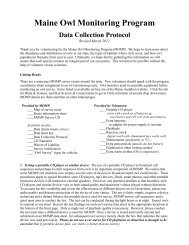Focus Species Forestry - Maine Audubon
Focus Species Forestry - Maine Audubon
Focus Species Forestry - Maine Audubon
You also want an ePaper? Increase the reach of your titles
YUMPU automatically turns print PDFs into web optimized ePapers that Google loves.
Appendix 3. Overview of Silvicultural Systems<br />
Single-tree Selection: Single-tree selection is a method of creating and maintaining an all-aged stand<br />
(typically 3 or more age classes separated by 20 or more years) by marking and removing individual trees.<br />
Removals, which typically occur at 15-25-year intervals, are designed to balance age and diameter classes<br />
of trees in the stand and encourage regeneration. This method works best for regenerating shade-tolerant<br />
species such as sugar maple, beech, hemlock, red spruce, and northern white cedar. Single-tree selection<br />
may be used to maintain a relatively continuous forest canopy and understory layers that benefit a range<br />
of mature-forest wildlife and plant species. Many stand are even-aged due to past land use history,<br />
conversion to an all-aged stand must be carefully planned.<br />
Group Selection: Group selection is a method for creating and maintaining an all-aged stand by marking<br />
and removing groups of trees on a periodic basis. Removals may range from groups of 3-4 trees,<br />
sometimes called “small group selection,” to openings of 0.5-2 acres in size (“large-group selection”) and<br />
may occur on a 15-20 year cycle. This method works well for both shade-tolerant and mid tolerant tree<br />
species. It is an excellent method for encouraging species such as yellow birch and white ash in northern<br />
hardwoods and can be used for pine-oak, spruce-fir, hemlock, and northern white cedar. As with singletree<br />
selection, conversion of even-aged stands to all-aged stands must be carefully planned.<br />
Because it results in small patches of early successional habitat within a relatively mature forest matrix,<br />
group selection is a good method to maintain habitat diversity on small ownerships. A mixture of group<br />
selection and individual-tree selection is consistent with the natural disturbance regimes of northern<br />
hardwoods, hemlock and cedar as well as spruce-fir on sites with relatively deep, well-drained soil.<br />
Shelterwood: The shelterwood method is used to regenerate the entire stand within a short period of<br />
time under a partial forest canopy. Typically 30-50% of the canopy is removed in the initial entry to<br />
stimulate regeneration. The canopy may be removed in one or two subsequent entries over the next 10-20<br />
years once the regeneration is established, or it may be retained for an extended period of time. The latter<br />
approach is called shelterwood-with-reserves, is used to develop and maintain a two-aged stand. By<br />
varying the level of canopy removal, the shelterwood method can be used to regenerate most forest types.<br />
The shelterwood method can be used to create large patches of early successional habitat while avoiding<br />
many of the negative aspects of clearcutting. By retaining patches of mature trees within a harvest block<br />
or using the shelterwood-with-reserves approach, the shelterwood method can be used to emulate natural<br />
disturbances associated with wind, fire, or insects characteristic of oak-pine forests, spruce-fir flats, highelevation<br />
spruce-fir, and spruce-fir on sites where windthrow is a high risk. However, long rotations (e.g.,<br />
greater than 70 years in spruce-fir, greater than 100 years in northern hardwoods or oak-pine) are<br />
necessary to develop mature forest conditions such as large live trees, snags, cavity trees, downed logs,<br />
and multiple canopy layers. It may be possible to speed development of mature forest conditions by<br />
retaining large, long-lived trees and encouraging regeneration during intermediate entries.<br />
Clearcutting: Clearcutting can be used to regenerate all forest types, but it is the least natural of all<br />
silvicultural systems. Concerns with clearcutting include the decay of organic matter and loss of nutrients<br />
due to high temperatures, soil disturbance, loss of understory plants that are sensitive to the harsh<br />
conditions of a clearcut, and loss of older trees that might be left after a natural disturbance. Where<br />
conifer regeneration is the objective, the use of herbicides is often necessary to achieve management<br />
goals. From an ecological perspective, clearcutting should only be used when it has been determined that<br />
management objectives cannot be attained with other silvicultural systems. When clearcuts must be used,<br />
their impacts can be mitigated by scattering tops and branches across the site, maintaining patches of<br />
<strong>Focus</strong> <strong>Species</strong> <strong>Forestry</strong> 77



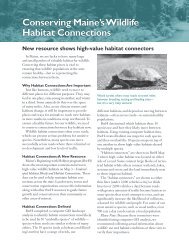
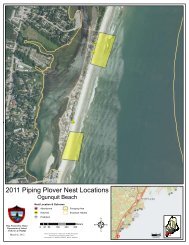

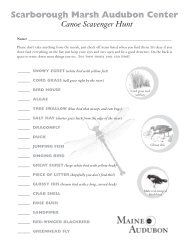


![2012 Loon Count Results [pdf] - Maine Audubon](https://img.yumpu.com/26228732/1/190x245/2012-loon-count-results-pdf-maine-audubon.jpg?quality=85)
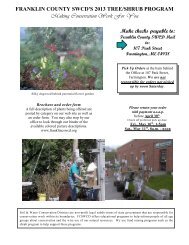
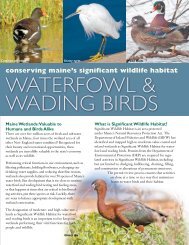
![Lake Fish of Maine (DIFW list) [pdf] - Maine Audubon](https://img.yumpu.com/23282964/1/190x245/lake-fish-of-maine-difw-list-pdf-maine-audubon.jpg?quality=85)
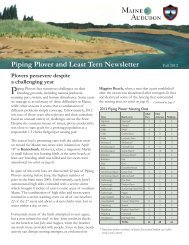

![The Maine Audubon Peony Circle of Friends 2012 [pdf]](https://img.yumpu.com/22707677/1/190x253/the-maine-audubon-peony-circle-of-friends-2012-pdf.jpg?quality=85)
